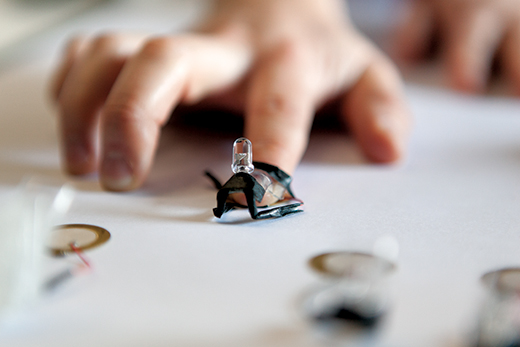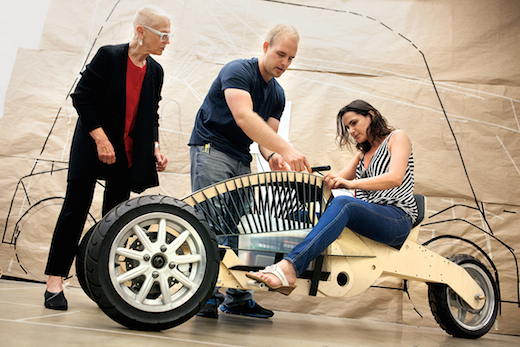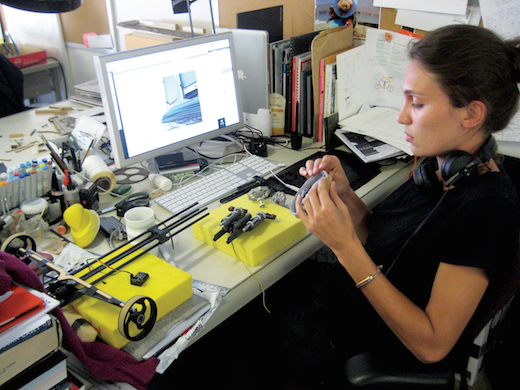
Media Design Practices students Kristina Ortega and Jenny Rodenhouse’s Wearable Services, created by the Intel-funded Connected Bodies course. Photo by Stella Kalinina
From business ventures to social justice, cultural research to experimental mediums, transportation systems to spatial experiences, Art Center’s renowned graduate programs offer designers and artists exceptional opportunities to create unique and personal career and life paths.
For the recently released 2015–16 Viewbook, Art Center Provost Fred Fehlau invited leaders from the College’s six graduate programs—Art, Environmental Design, Film, Industrial Design, Media Design Practices, and Transportation Systems and Design—to offer their perspectives on the current state of their fields, and what it means for prospective graduate students.
Fred Fehlau, Provost: What has changed in the last 10 years—in your program and in the field—that makes graduate study at Art Center so relevant?
Anne Burdick, Media Design Practices Chair: Today’s global systems of information, goods and power bring with them a stream of complex sociological questions and challenges. It’s not enough to say you’re preparing interaction and media designers for rapidly changing technological futures—the question is whose futures? To answer this question with depth and criticality, we recently restructured our curriculum into two distinct tracks—Lab and Field. Lab students prepare to work in the resource-rich cutting-edge science and tech domains—areas in which designers explore the cultural impact of new discoveries. Field students address hard-hitting social issues by moving between fieldwork abroad and our partner organizations’ headquarters, using design to challenge the conventions of international development. Our philosophy has always been that divergent perspectives can generate new thinking; the co-existence of these two tracks takes that one step further.
Jeremy Gilbert-Rolfe, Former Art Chair: Graduate Art cultivates students working in mediums from the traditional to the wholly contemporary, and from many different artistic and intellectual backgrounds. This means our program both responds to and anticipates changes in the field. Two parallel developments in the last decade seem to define where we find ourselves today. On the one hand, there’s been a resurgence of interest in painting and sculpture; on the other, the Museum of Modern Art has started taking video games into its collection. At Art Center we have always had artists working in both the traditional arts and with the newest technologies.

To create his graduate Film project, director Elran Ofir tapped skilled student talent for his crew including Aaron Shapiro (BFA 12) as director of photography. Photo by Stella Kalinina
Ross LaManna, Film Chair: The biggest change in the last decade is box office globalization. Foreign revenues now make up, on average, two-thirds of a film’s total revenue. Accordingly, great visual storytelling skills that transcend language and cultural boundaries have become highly valued. A graduate Film education at Art Center combines rigorous, individualized, hands-on classes covering all technical aspects of filmmaking, combined with a strong foundation in critical studies and an immersion in visual storytelling techniques. Entrepreneurialism, a cornerstone of our curriculum, is also essential for success in the contemporary entertainment industry. Our apprentice filmmakers are treated like professionals, not students. Each student’s curriculum is tailored to best meet their needs based on their interests and experience. They create their own projects; they choose their crew; they own their negatives.
David Mocarski, Environmental Design Chair: Everything about how we do business has changed: from the way we conceive ideas and build stories to the tools we use and how things are fabricated. The main changes are shifts towards brand-driven sensorial spatial design and industry-driven furniture and fixtures design. Our entering students tell us they searched far and wide and that we offered the only industry-focused program. Most students entering our Spatial Experience track come from architectural programs that still teach architecture as monument building. They see that the industry is changing to strong research-, narrative- and design strategy-driven projects. In our Furniture and Fixtures track, our students come from traditional furniture programs or product design programs that have only taught style-driven, singular-focused object design, but not total sensorial experience design.

Environmental Design graduate student Karan Singh Gandhi with a lighting project he created in the Furniture and Fixtures track. Photo by Stella Kalinina
Andy Ogden, Industrial Design Chair: Over the last 10 years we’ve seen unprecedented cultural changes amplified by the development of new technologies that have increased market competition and disrupted previously stable business models. As a result, organizations everywhere find themselves challenged to remain relevant to the communities they serve. They need to continuously reinvent themselves and redesign how they achieve their business goals by providing new value to customers whose needs and choices keep changing. These companies have a great need for creative professionals who have the ability to understand their unique issues from a systems view, design a successful way forward for their enterprise, and inspire others in the organization to work together to make it real. Our program is uniquely designed to prepare individuals to thrive in this role.
Geoff Wardle, Transportation Systems and Design Executive Director: The automotive industry—overwhelmingly the most supportive sector of the transportation field to Art Center—faces an uncertain future due to numerous factors, including: an emerging Chinese automotive industry poised to challenge U.S., European, Japanese and Korean companies; increasing public dissatisfaction with the car as a means of transportation; strong political, public and scientific pressure to reduce the environmental impact of automobiles; and rising interest in different solutions to urban mobility problems. Unfortunately, transportation designers are not at the forefront of conversations, initiatives or study groups for these issues—they’re usually delegated to making vehicular and transportation products “look beautiful.” There’s an urgent need for a new kind of transportation designer, one who understands that the real value of design stretches way beyond styling. This is what Transportation Systems and Design is all about.

Graduate Transportation Systems and Design student Garrett DeBry (center) and his personal transportation vehicle full-scale prototype. Photo by Stella Kalinina
Fehlau: What are the most urgent questions students in your program are currently addressing?
LaManna: While opportunities to find an audience for one’s work are expanding due to the proliferation of cable TV channels, online distribution platforms and micro-budget filmmaking, the economies of a career in entertainment have evolved drastically. It’s essential for film students to learn how to practically manage a gratifying, productive and financially sustainable life in show business. They can no longer focus their ambition and interest solely on one specific aspect of moviemaking, such as writing, editing or directing. Anyone interested in contributing creatively to the filmmaking process needs a deep overall understanding of the crafts, technologies and artistry of visual storytelling. Today, thanks to the new availability of inexpensive but professional-quality filmmaking, post-production and visual-effects tools, contemporary moviemakers have an unprecedented opportunity to take their creative ideas all the way from conception to distribution.
Mocarski: A major reason young designers seek a graduate education is that the world is changing at an alarming pace along with the creative skill sets necessary to stay relevant. For designers, our work is no longer a styling discipline. Design has become holistic. We draw from culture, not napkin sketches. In order to make an impact, designers need to understand the users they are designing for, the brand, materials and manufacturing. They need to understand pricing and business practices. They need to study current trends and historical influences in order to re-examine how we can interface with the future. Changes in the world have opened up more options to creatively interact with culture, but all these changes require more time and more thought—a depth beyond what most undergraduate programs offer.

Presentation by critic Christopher Wool as part of the Spring 2014 Graduate Art Seminar lecture series. Photo by Stella Kalinina
Wardle: Our graduate Transportation students are addressing the fundamental forces that shape the world of transportation to see where they can most effectively bring about real change. They’re seeing through the obvious manifestations of transportation—cars, trains, bike lanes—and asking the question: Why this? At the same time, they are learning how to understand the needs, aspirations and expectations of end users and all other stakeholders. They’re researching how designers can effect change by facilitating and leading cross-disciplinary collaboration. Transportation is too huge a field for designers to work in alone. Alone, our voice is not heard. Harnessing our creativity to lead progress through strategic big-picture thinking, empathizing with all the stakeholders in transportation, and facilitating meaningful collaboration among them is the future of the profession.
Fehlau: What kinds of research and critical discourse within your discipline are producing new insights?
Burdick: Through designing and writing, our core faculty participate in the lively debates of critical design, human-computer interaction, social innovation, architectural theory, anthropology, the digital humanities, design research and more. Ben Hooker and Tim Durfee are working on “The Metropolis of Me”—a way of understanding the city as social media. I just completed a book titled Digital_Humanities about design and knowledge in the networked age. Sean Donahue, who is also a visiting researcher at the Royal College of Art, works on the future of aging. Elizabeth Chin brings the critique of afrofuturism to speculative design with her “Laboratory of Speculative Ethnography.” And Phil van Allen’s “object animism” explores the Internet of Things. That’s just a sample—at the graduate level we continually expect our students, faculty and alumni to produce new insights.

Students in graduate Industrial Design, like Nina Viggi (MS 13), engage in research that prepares them to take on complex and unstructured problems.
Gilbert-Rolfe: Our program has always responded to social and cultural developments—Mike Kelley, for example, was one of our founding core faculty members—and has come to represent more contemporary approaches to the social, political and socio-anthropological. At the same time, our program’s strength lies in its diversity of approaches and mediums, and their messy relationships to one another. When our students engage with new mediums or technology, several outcomes are possible: they do something unexpected with the technology, including exhausting or breaking it; they create work that consciously or involuntarily imitates or embodies the medium’s visual qualities; or they explore or critique the effects the technology is having on both the shape and meaning of art as well as the larger world. In our program, we represent all these approaches.
Ogden: Our students engage in research and critical discourse that prepares them to take on the kinds of complex and unstructured problems companies face today. We study the behavior of organizations and explore the dynamics of cross-disciplinary teams. We develop analytical and systematic methods adapted from the fields of business, future studies, systems dynamics, the humanities, sciences and technical fields and then combine them with the perceptual literacy, “making” skills and creative thought process inherent in the art and design fields. The result is an evolving methodology for illuminating important areas of opportunity across a broad range of products and services focused on unmet human needs and aspirations. We explore new methods to visualize and validate—complete with new business models—our ideas for a better future.









that is great. i like it